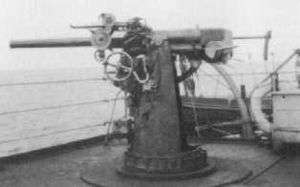HMS Sir John Moore (1915)
| History | |
|---|---|
| Name: | HMS Sir John Moore |
| Builder: | Scotts, Greenock |
| Laid down: | 13 January 1915 |
| Launched: | 31 May 1915 |
| Decommissioned: | 1921 |
| Fate: | Sold for scrapping 1921 |
| General characteristics | |
| Class and type: | Lord Clive-class monitor |
| Displacement: | 6,150 tons |
| Length: | 335 ft (102.1 m) |
| Beam: | 87 ft (26.5 m) |
| Draught: | 9.7 ft (3.0 m) |
| Propulsion: | 2 shafts, reciprocating steam engines, 2 boilers, 2,310 hp |
| Speed: | 6.5 knots (12.0 km/h) |
| Complement: | 187 |
| Armament: | 2 × BL 12-inch (304.8 mm) Mk VIII guns in a single turret, two QF 3-pounder guns. |

HMS Sir John Moore was a First World War Royal Navy Lord Clive-class monitor named for Sir John Moore, a British general of the Peninsula War who was killed in action during the Battle of Corunna. Her 12" main battery was stripped from the obsolete Majestic-class battleship HMS Hannibal, which had been converted into a troopship.
The Lord Clive class monitors were built in 1915 to engage German shore artillery and positions in occupied Belgium during the First World War. Sir John Moore, with her sisters was regularly engaged in this service in the Dover Monitor Squadron, bombarding German positions along the coast and someway inland with their heavy guns.
Following the armistice in November 1918, Sir John Moore and all her sisters were put into reserve pending scrapping, as the reason for their existence had ended with the liberation of Belgium. In 1921 Sir John Moore and four of her sisters were scrapped.
References
- Dittmar, F. J.; Colledge, J. J. (1972). British Warships 1914–1919. London, UK: Ian Allen. ISBN 978-0-7110-0380-4.
- Gardiner, Robert; Gray, Randal, eds. (1985). Conway's All the World's Fighting Ships, 1906–1921. London, UK: Conway Maritime Press. ISBN 978-0-85177-245-5. OCLC 12227060.